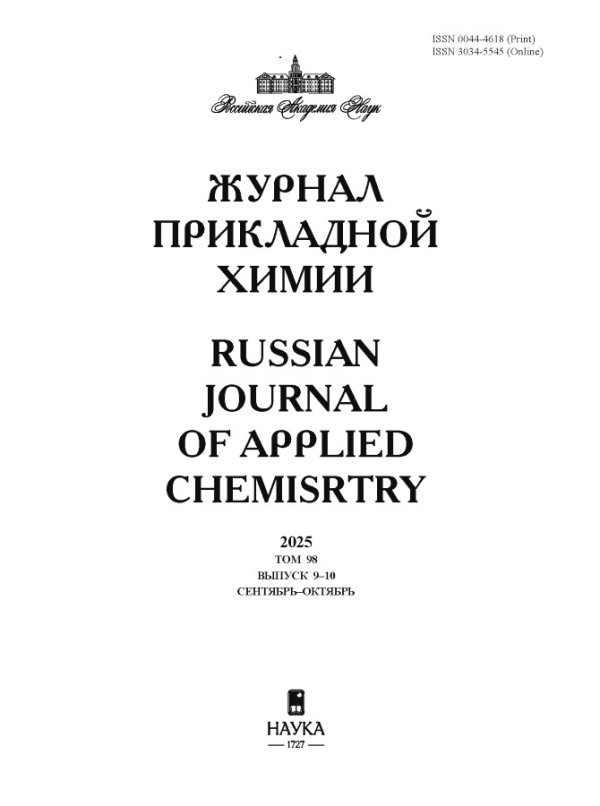Effect of the Nature and Concentration of the Fuel on the Structure and Morphology of ZnO Microspheres Produced via Spray Solution Combustion Synthesis
- Authors: Ermekova Z.S.1, Roslyakov S.I.1, Yurlov S.S.1, Bindyug D.V.1, Chernyshova E.V.1, Savilov S.V2,3
-
Affiliations:
- National University of Science and Technology MISIS
- Moscow State University
- Topchiev Institute of Petrochemical Synthesis, Russian Academy of Sciences
- Issue: Vol 96, No 4 (2023)
- Pages: 330-336
- Section: Articles
- URL: https://modernonco.orscience.ru/0044-4618/article/view/668143
- DOI: https://doi.org/10.31857/S0044461823040011
- EDN: https://elibrary.ru/OEVYWW
- ID: 668143
Cite item
Abstract
Synthesis of ultradisperse spherical ZnO powders was accomplished by spray solution combustion, employing four distinct fuels, namely methenamine, glycine, urea, and citric acid. Using X-ray diffraction analysis, scanning electron microscopy, and low-temperature nitrogen adsorption, the impact of the main process parameters (composition and concentration of fuel, temperature and rate of the carrier gas flow) on the structure and morphology of ZnO particles was demonstrated. A synthesis temperature of 700°C was found to be sufficient to generate crystalline ZnO with a homogeneous phase composition, regardless of the type and amount of fuel. It was shown that the initial pH of the precursor solution does not affect the formation of the ZnO phase. At rates of carrier gas flow above 4 L min–1, the presence of by-products is detected. It has been determined that the excess and type of fuel significantly affect the morphology of the synthesized ZnO microspheres and can be used to control the technological characteristics of the powder and the kinetics of sintering.
About the authors
Zh. S. Ermekova
National University of Science and Technology MISIS
Email: acjournal.nauka.nw@yandex.ru
119049, Moscow, Russia
S. I. Roslyakov
National University of Science and Technology MISIS
Email: acjournal.nauka.nw@yandex.ru
119049, Moscow, Russia
S. S. Yurlov
National University of Science and Technology MISIS
Email: acjournal.nauka.nw@yandex.ru
119049, Moscow, Russia
D. V. Bindyug
National University of Science and Technology MISIS
Email: acjournal.nauka.nw@yandex.ru
119049, Moscow, Russia
E. V. Chernyshova
National University of Science and Technology MISIS
Email: acjournal.nauka.nw@yandex.ru
119049, Moscow, Russia
S. V Savilov
Moscow State University; Topchiev Institute of Petrochemical Synthesis, Russian Academy of Sciences
Author for correspondence.
Email: acjournal.nauka.nw@yandex.ru
119991, Moscow, Russia; 119991, Moscow, Russia
References
- Klingshirn C. ZnO: Material, physics and applications // ChemPhysChem. 2007. V. 8. N 6. P. 782-803. https://doi.org/10.1002/cphc.200700002
- Ren G., Lan J., Zeng C., Liu Y., Zha B., Butt S., Nan C. W. High performance oxides-based thermoelectric materials // JOM. 2015. V. 67. P. 211-221. https://doi.org/10.1007/s11837-014-1218-2
- Bugalia A., Gupta V., Thakur N. Strategies to enhance the performance of thermoelectric materials: A review //j. Renew. Sustain. Energy. 2023. V. 15. ID 032704. https://doi.org/10.1063/5.0147000
- Prasad R., Bhame S. D. Review on texturization effects in thermoelectric oxides // Mater. Renew. Sustain. Energy. 2020. V. 9. P. 1-22. https://doi.org/10.1007/s40243-019-0163-y
- Kolodziejczak-Radzimska A., Jesionowski T. Zinc oxide-from synthesis to application: A review // Materials. 2014. V. 7. P. 2833-2881. https://doi.org/10.3390/ma7042833
- Prabhuraj T., Prabhu S., Dhandapani E., Duraisamy N., Ramesh R., Kumar K. R., Maadeswaran P. Bifunctional ZnO sphere/r-GO composites for supercapacitor and photocatalytic activity of organic dye degradation // Diamond Relat. Mater. 2021. V. 120. ID 108592. https://doi.org/10.1016/j.diamond.2021.108592
- Xing Y., Zhang L. X., Chong M. X., Yin Y. Y., Li C. T., Bie L. J. In-situ construction of carbon-doped ZnO hollow spheres for highly efficient dimethylamine detection // Sens. Actuators. B. 2022. V. 369. ID 132356. https://doi.org/10.2139/ssrn.4009448
- Lee Y., Fujimoto T., Yamanaka S. Characterization of submicro-sized Ag/ZnO particles generated using the spray pyrolysis method // Adv. Powder Technol. 2022. V. 33. ID 103525. https://doi.org/10.1016/j.apt.2022.103525.
- Trusov G. V., Tarasov A. B., Goodilin E. A., Rogachev A. S., Roslyakov S. I., Rouvimov S., Mukasyan A. S. Spray solution combustion synthesis of metallic hollow microspheres //j. Phys. Chem. C. 2016. V. 120. N 13. P. 7165-7171. https://doi.org/10.1021/acs.jpcc.6b00788
- Yermekova Z., Trusov G., Roslyakov S. I. Spray solution combustion synthesis of NiCu hollow spheres // Int. Conf. on Mechanical, System and Control Engineer. Singapore: Springer Singapore, 2021. P. 11-17. https://doi.org/10.1007/978-981-16-9632-9_2
- Konstantinova E. A., Minnekhanov A. A., Trusov G. V., Kytin V. G. Titania-based nanoheterostructured microspheres for prolonged visible-light-driven photocatalysis // Nanotech. 2020. V. 31. ID 32392554. https://doi.org/10.1088/1361-6528/ab91f1
- Varma A., Mukasyan A. S., Rogachev A. S., Manukyan K. V. Solution combustion synthesis of nanoscale materials // Chem. Rev. 2016. V. 116. N 23. P. 14493-14586. https://doi.org/10.1021/acs.chemrev.6b00279
- Roslyakov S., Yermekova Z., Trusov G., Khort A., Evdokimenko N., Bindiug D., Mukasyan A. One-step solution combustion synthesis of nanostructured transition metal antiperovskite nitride and alloy // Nano-Struct. Nano-Objects. 2021. V. 28. ID 100796. https://doi.org/10.1016/j.nanoso.2021.10079
- Trusov G. V., Tarasov A. B., Moskovskikh D. O., Rogachev A. S., Mukasyan A. S. High porous cellular materials by spray solution combustion synthesis and spark plasma sintering //j. Alloys Compd. 2019. V. 779. P. 557-565. https://doi.org/10.1016/j.jallcom.2018.11.250
- Nesakumar N., Rayappan J. B. B., Jeyaprakas B. G., Krishnan U. M. Influence of pH on structural morphology of ZnO nanoparticle // Asian J. Appl. Sci. 2012. V. 12. N 16. P. 1758-1761. https://doi.org/10.3923/jas.2012.1758.1761
Supplementary files








